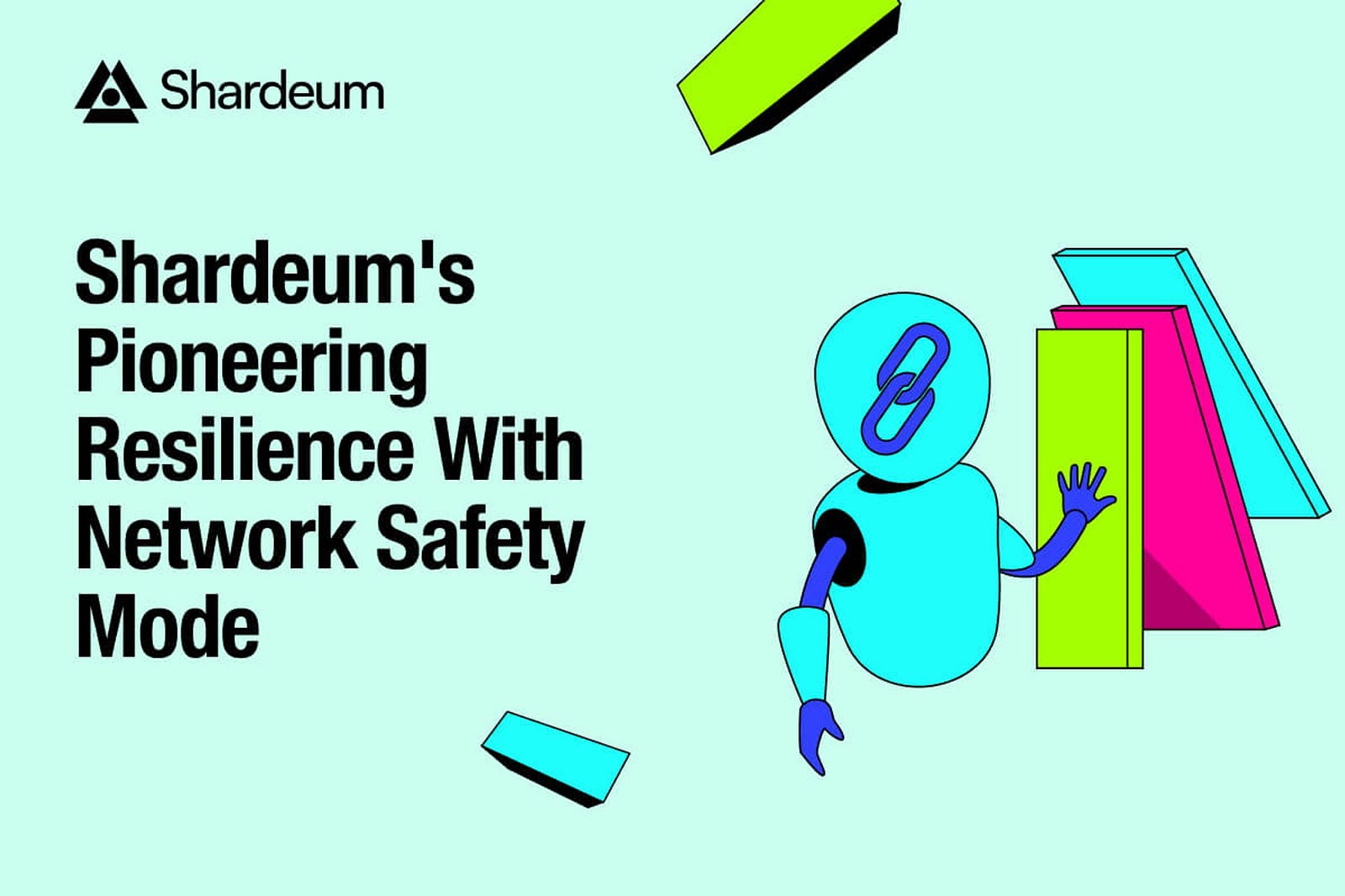Shardeum's Fortress Protocol: Architecting Blockchain Resilience
 Sahana
Sahana
Promoting Innovation & Education in Web3
The brilliance of nature’s design has long inspired human ingenuity. From the innovative geometry of honeycomb structures to the aerodynamic excellence of avian forms, echoes of the natural world reverberate through our greatest engineering marvels. At Shardeum, we’ve taken a page from nature’s book, meticulously architecting a blockchain ecosystem that emulates the resilience and self-preserving mechanisms of biological systems.
As we forge ahead on our mission to birth the world’s first linearly scalable smart contract platform, our exceptional team of engineers has unveiled a pioneering breakthrough — the implementation of adaptive “network modes.” Among these is the revolutionary “Safety Mode”, a first-of-its-kind immune response for the blockchain realm.
Much like the human body marshalling its defenses against pathogens and environmental threats, Safety Mode ensures Shardeum can temporarily pause application transactions if suboptimal network conditions arise. This innovative paralysis acts as a digital quarantine, allowing the network to process transactions and sync data seamlessly as long as active nodes remain online.
Akin to the body’s biological countermeasures, Safety Mode is a pre-emptive safeguard, preventing minor issues from spiraling into catastrophic network failures. By promoting self-preservation, this paradigm-shifting innovation underscores Shardeum’s commitment to ensuring long-term sustainability, decentralization, and an unparalleled user experience.
As we prepare to unveil a series of behind-the-scenes revelations that showcase our trailblazing efforts, this resilience breakthrough stands as a testament to the thorough preparedness and advanced technology that form the bedrock of the Shardeum ecosystem. Brace yourself for insights that will inspire the community and catalyze future Web3 innovations!
The Shardeum odyssey continues, fueled by our unwavering dedication to democratizing blockchain accessibility without compromising on security or scalability. As we cross this monumental threshold, our trail blazes ever brighter, illuminating the path towards a decentralized future that is truly built to last.
Shardeum has recently published an article about the network modes with a
focus on "Recovery Mode" that allowed Shardeum to easily overcome a major
betanet crash making it the first sharded blockchain network to self-restore
all its data.
Check it out here!!
Understanding the Network Modes on Shardeum
With this latest Shardeum upgrade, network modes (including the key safety mode) have been successfully integrated into the Shardus network. Network modes are essentially different operational states that the network can be in, allowing it to effectively manage its entire lifecycle — from formation, regular operation, potential crisis situations, and even recovery.
It’s important to note that while having these modes brings great benefits, some modes like restart or shutdown may never actually be needed on Shardeum. For example, it would take almost all validators going offline to trigger a restart. However, Shardeum has these modes prepared just in case, to be ready for even the most unlikely scenarios.
Shardeum’s Seven (Wonders!) Network Modes
Shardeum has seven different network modes that act like traffic signals, guiding how the network behaves based on the number of active validators and other key conditions. Let’s break them down:
Forming — This initial phase allows new nodes to join and sync data until a minimum number is reached to prepare for operations.
Processing — The normal operational mode where the network processes transactions. Nodes can join, leave or be replaced as needed.
Safety — Triggered if stability is at risk. This mode stops application transactions to safeguard integrity, only allowing protocol transactions.
Recovery — If not enough nodes are active, this mode stops application transactions and data syncing to quickly add standby nodes.
Restart — Used to reboot the network if too many nodes are lost. New nodes join without app data to reach minimum numbers quickly.
Restore — Nodes sync full data from other nodes/archives to become fully active again after recovery/restart.
Shutdown — Halts all transactions and operations in preparation for an intended network shutdown.
The existence of these modes, even modes that may seem extreme like shutdown, ensures Shardeum is incredibly resilient and prepared for any conditions. We’ll start by exploring the safety mode and its benefits for network resilience. The other modes will be covered in upcoming posts.
Features and Benefits of Safety Mode
1. Safety First
Safety Mode ensures that if there is a major drop in active validators, Shardeum will switch into a protective state. It will prioritize syncing data over processing application transactions.
2. Network Stability & Security
This mode is designed to maintain network stability when the number of active nodes drops below a certain level. By only allowing protocol transactions, it reduces the operational load and complexity, helping to keep the core network functions secure.
3. Prevents Data Loss
In sharded systems, losing many nodes risks data integrity for the shards those nodes manage. Safety mode prevents incorrect transaction processing or data loss due to insufficient node coverage.
4. Automatic Response
Safety mode automatically triggers in response to sudden drops in node participation. This automated switch can prevent cascading failures that could happen if the network operated normally with too few nodes.
5. Aids Network Recovery
By only focusing on protocol transactions, the network operates in a reduced but easier to maintain state. This simplified operation helps new or recovering nodes sync and re-join the network.
6. Maintains Consensus
Maintaining consensus is vital in decentralized systems. Safety mode preserves consensus integrity by reducing operational complexity so remaining nodes agree on the network state.
7. Protects Against Attacks
If nodes drop due to an attack, safety mode reduces vulnerabilities, as only essential transactions occur, limiting exploit opportunities in a weakened state.
8. Ensures Core Operations
Even in a reduced capacity, safety mode ensures critical network operations like updates and maintenance continue to function normally.
In essence, safety mode acts as a crucial safety net that ensures network stability, prevents data loss, aids recovery, and maintains consensus integrity when there are issues impacting active node levels. This improves Shardeum’s resilience and long-term sustainability.
Advantages of Network Modes in Shardeum: An Insight
Shardeum’s network modes provide a comprehensive framework that allows the network to dynamically adapt to different operational conditions and scenarios. This multi-modal approach brings several key advantages:
Rapid Network Formation: The forming mode enables a swift onboarding process for new nodes, allowing the network to reach its operational capacity quickly. This agility is crucial for meeting demand surges and maintaining a robust validator set.
Efficient Node Rotation and Scaling: During normal processing operations, validators can be rotated seamlessly, balancing network demand with validator availability. Additionally, the network can dynamically scale up or down based on transaction volumes, ensuring optimal performance and resource utilization.
Robust Recovery Mechanisms: Even if validator participation drops significantly, Shardeum’s recovery mode acts as a lifeline, stabilizing the network and facilitating a coordinated rebuilding process. This safeguards against extended downtimes or data loss.
Collaborative Resilience with Archivers: The restart mode, combined with the role of Archivers, provides an additional layer of resilience. Even in the extremely unlikely event of total active validator loss, the network can recover and restart from archived data, ensuring continuity.
Rapid Restarts and Syncing: Restart and restore modes are designed for swift network resurrection and efficient data synchronization. This minimizes downtime and ensures nodes can quickly catch up to the latest state, maintaining a smooth user experience.
Adaptability and Continuous Improvement: The implementation of these modes is a learning experience, providing insights into network dynamics and edge cases. This knowledge can drive future innovations, allowing Shardeum to evolve and adapt to emerging challenges proactively.
Shoutout to the Stellar Shardians
In essence, Shardeum’s multi-modal network design imbues the system with flexibility, resilience, and the ability to self-preserve under various conditions. This holistic approach not only ensures operational robustness but also lays the foundation for long-term sustainability and scalability in the evolving blockchain landscape.
Shardeum wants to thank their passionate Shardian community, their dedicated node operators, tirelessly powering the network, their ecosystem collaborators innovating alongside Shardeum, and Shardeum’s invaluable partners propelling themforward — a heartfelt THANK YOU from the entire Shardeum team! 🌍
Together, as a united front, we are shaping the future of decentralized ecosystems and ushering in a new era of blockchain accessibility and scalability. Your belief in our vision fortifies our resolve to push boundaries and deliver ground-breaking solutions.
So to every Shardian, node operator, collaborator, and partner — thank you. Your conviction ignites our passion, and your dedication propels our relentless pursuit of innovation and excellence. The odyssey continues, fueled by the spirit of this remarkable community.
Conclusion
The implementation of Network Modes, especially the groundbreaking Safety Mode, marks a watershed moment for Shardeum. It elevates our platform to new heights of resilience, adaptability, and robust sustainability in the face of any challenges. This breakthrough exemplifies our steadfast commitment to architecting a future-proof blockchain ecosystem that harmoniously combines scalability, security, and the ability to thrive under any conditions.
At its core, Safety Mode serves as a preemptive digital immune system, safeguarding network integrity by prioritizing data synchronization over transaction processing when faced with suboptimal circumstances. But Network Modes go far beyond just defensive measures — they govern Shardeum’s entire operational lifecycle with impressive efficiency and agility. From rapidly onboarding new nodes to seamlessly rotating validators based on demand, these modes unlock new realms of scalability.
This resilience milestone wouldn’t be possible without the tireless efforts of our engineering teams and the invaluable support of our passionate Shardian community. Your energy fortifies our pursuit of excellence, your commitment solidifies our vision of pioneering Web3 accessibility and decentralization. Together, we forge ahead, trailblazing new frontiers as we elevate Shardeum into a safer, swifter, and stronger smart contract platform for the world.
Shardeum’s Socials 🚀
Official Website -> https://shardeum.org/
Twitter -> https://twitter.com/shardeum
Telegram -> https://t.me/shardeum
Linkdein -> https://linkedin.com/company/shardeum
Discord -> https://discord.gg/shardeum
Subscribe to my newsletter
Read articles from Sahana directly inside your inbox. Subscribe to the newsletter, and don't miss out.
Written by
